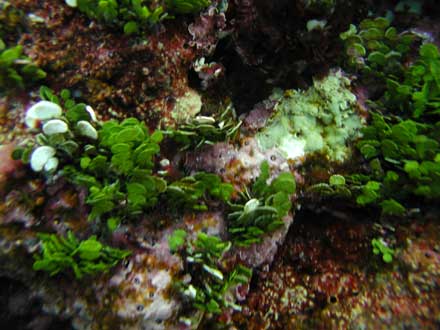NOWRAMP
2002
Creature
Feature - Halimeda algae
Halimeda
algae
Halimeda opuntia ()

Halimeda
opuntia, photo by
Larry Basch, NPS.
This
green seaweed, Halimeda, was the first we saw underwater
at Mokumanamana, scattered across the surge swept limestone
platform in between sand patches and little bushy Laurencia
tufts, a red seaweed.
Halimeda
is calcified, meaning that all around its cell walls is
a deposit of calcium carbonate. Halimeda is prevalent in
most tropical ocean waters. It is famous for being the source
of "oatmeal sand". As you can see in the picture,
as segments of the plant die the calcified parts remain
intact. These break off to form white flakes that pile up
to make significant amounts of sea floor sediment on reefs
and in lagoons. The specimen pictured was found off of Mokumanamana
(Necker Island).
Some
fish eat Halimeda and there are even small sea slugs that
suck the cell sap!
From:
Karla McDermid, Expedition Scientist
 Talk About It!
Talk About It!
What are the benefits of Halimeda?
Asked by Alief on Feb 22, 2003.
What are the benefits of Halimeda for humans possible uses)? How deep did you go?
Answered by Karla of the NOW-RAMP Crew on Feb 23, 2003.
Halimeda is an important contributor to marine sediments on reefs and in tropical lagoons. In a recent literature search conducted by my students, I don't recall any human uses for Halimeda. Our deepest dive on NOWRAMP was about 85 feet.